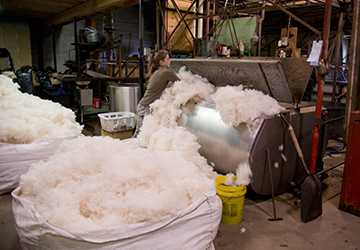Cashmere epitomizes the zenith of refinement and sumptuousness, securing its esteemed position within the echelons of premium textiles through its superior characteristics that command a distinguished price. This exploration into why cashmere is expensive, alongside the discernible benefits of cashmere fabric, endeavours to illuminate the cashmere luxury factors that elevate its status beyond a mere material but celebrate it as a symbol of cultivated elegance.

Cashmere Luxury Factors
The genesis of cashmere's opulence lies in the delicate undercoat of Capra Hircus goats, native to the formidable climates of regions such as Mongolia and China. These austere environments are pivotal in fostering the fibre's renowned attributes of incomparable softness, thermal efficiency, and robustness—quintessential cashmere luxury factors.
● Elusive Rarity and Exclusivity: Each goat's meagre yield of pure cashmere, approximately 150 grams post-refinement annually, underscores its scarcity and augments its luxurious appeal.
● Supreme Softness Coupled with Thermal Insulation: Cashmere's unmatched softness, coupled with its ability to insulate effectively without cumbersome bulk, is a primary benefit of this fabric, which is covered in the luxury textile domain.
● Perennial Durability and Elegance: Cashmere items can last for decades with proper care, representing an acquisition and a respectable investment in lasting quality and aesthetic elegance.
Why is Cashmere Expensive?
Grasping why cashmere is expensive necessitates an appreciation for its labour-intensive and meticulous production journey, emphasizing craftsmanship and precision at every juncture to ensure each fibre embodies the pinnacle of luxury.
● Arduous Harvesting Endeavor: The traditional hand-combing technique employed during the spring moulting period to harvest the undercoat is a testament to the artisanal dedication inherent in crafting cashmere, significantly contributing to its expensiveness.
● Exacting Fiber Selection and Cultivation: Following harvest, the fibres undergo a stringent selection process, where only those of the highest calibre are chosen for processing into yarn. This further accentuates the cashmere luxury factors.
● Artisanal Mastery and Distinction: Converting cashmere fibres into sartorial masterpieces frequently involves the expertise of skilled artisans, who infuse each piece with a touch of individuality and exclusivity.
Benefits of Cashmere Fabric
The benefits of cashmere fabric extend beyond its palpable luxury. It encompasses attributes of practicality and versatility, making it a preferred selection for those with an appreciation for the finer aspects of life.
● Optimal Warmth with Minimal Bulk: Cashmere's exceptional insulation properties, without the heft, render it ideal for refined layering in cooler climates, offering an amalgamation of warmth and elegance.
● Inherent Breathability and Moisture Regulation: Unlike synthetic alternatives, cashmere's natural ability to wick moisture while permitting skin breathability enhances its wearability and comfort.
● Allergen-Free Comfort for Sensitive Skin: Cashmere's natural composition makes it less likely to provoke allergies, offering solace for sensitive skin types.
● Timeless Elegance and Versatile Fashionability: Cashmere's enduring appeal ensures its seamless integration into both casual and formal attire, symbolizing sophistication and a timeless sense of style.
Illuminating the Environmental Impact of Cashmere
With the escalating demand for opulence, the environmental ramifications of cashmere fabrication have emerged as critical concerns among aficionados and sector protagonists alike. Integrating eco-conscious methodologies in the procurement and creation of cashmere not only mitigates adverse ecological effects but also weaves a narrative of affluence paired with stewardship and conscientiousness.
Eco-Conscious Herding Techniques: Efforts dedicated to fostering ecologically sound grazing and herding tactics stand at the forefront of minimizing the environmental imprint left by cashmere production. These initiatives are crucial in safeguarding the natural ecosystems and biodiversity endemic to cashmere-producing locales.
Green Processing Practices: Adopting green practices in the cleaning, colouring, and final finishing of cashmere products dramatically reduces water and chemical consumption, marking the industry's shift towards more sustainable luxury goods.
Pioneering in Cashmere Reclamation
The realm of cashmere is witnessing a renaissance with the introduction of recycling innovations that ensure sustainability without sacrificing excellence. Cashmere reclaimed from consumer and industrial remnants presents a conduit to opulent consumption with diminished ecological detriments.
Promoting a Recyclable Fashion Paradigm: The reclamation of cashmere stands as a beacon for propelling a recyclable fashion ecosystem. It converts erstwhile apparel into superior-quality threads for new creations. This movement not only preserves resources but also perpetuates the lifecycle of these esteemed fibres.
Revolutionary Fiber Revitalization Techniques: State-of-the-art methodologies in fibre renewal and reclamation refine the calibre of reclaimed cashmere, assuring that such items uphold the lofty standards of virgin cashmere in softness and resilience.
Celebrating the Craftsmanship Heritage of Cashmere
Every segment of cashmere is imbued with a rich narrative of cultural legacy and skilled artisanship that traverses generations. The ancestral techniques utilized in cashmere craftsmanship echo the material's profound historical and artistic essence, surpassing its physical attributes.

Heritage of Craftsmanship: The art of fibre gathering, classification, and yarn spinning in cashmere's native regions is steeped in tradition, passed from one generation to the next as a treasured artisanal legacy.
Empowering Artisanal Communities: Acknowledging and conserving the age-old craftsmanship of cashmere fortifies local communities and uplifts the artisans’ economic well-being, ensuring their invaluable skills are acknowledged and perpetuated.
The Intangible Charm of Cashmere
Cashmere's allure transcends its tactile and practical qualities, touching upon a psychological sphere that resonates deeply with luxury connoisseurs. The esteemed status associated with cashmere apparel taps into an innate yearning for distinctiveness, solace, and profound contentment.
Emblem of Distinction and Attainment: Possessing cashmere articles often symbolizes a significant personal or professional milestone, manifesting the aspirations and achievements of the bearer.
Sensory Delight and Emotional Solace: Cashmere's unmatched suppleness and cosiness provide not only physical comfort but also a profound sense of emotional security and luxury, offering a palpable manifestation of care and opulence.
Conclusion
To conclude, the luxury factors of cashmere, combined with the artisanal craftsmanship and tangible benefits of cashmere fabric, articulate why cashmere is expensive. This magnificent material transcends simple aesthetic allure, presenting warmth, comfort, and an emblem of refined taste. Cashmere represents an enduring investment for those prioritizing quality and sustainable luxury, outlasting ephemeral trends and bestowing perpetual elegance and unmatched value.
















